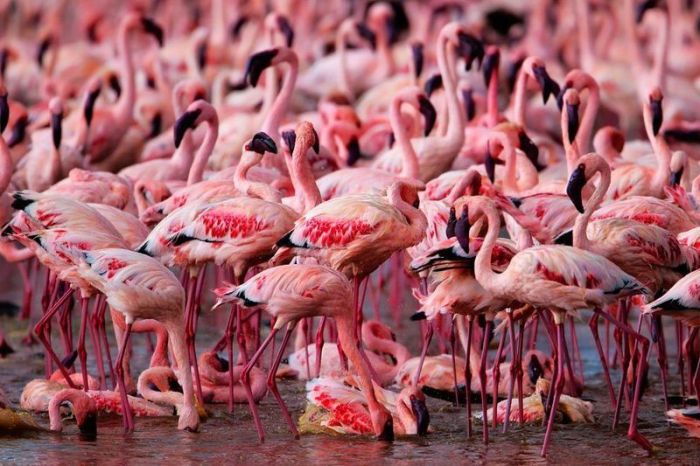|
|
Pink Blanket Of Flamingos, Rift Valley Lakes, Nakuru Lake National Park, Kenya
|
The identity of the closest relatives of the flamingos is a rather contentious issue. A wide variety of birds have been proposed as their closest relatives, on a wide variety of evidence. To reflect the uncertainty about this matter, flamingos are generally placed in their own order. Recent molecular and anatomical studies have suggested a relation with grebes.
Traditionally, the long-legged Ciconiiformes, probably a paraphyletic assemblage, have been considered the flamingos' closest relatives and the family was included in the order. Usually the ibises and spoonbills of the Threskiornithidae were considered their closest relatives within this order. Earlier genetic studies, such as those of Charles Sibley and colleagues, also supported this relationship. Relationships to the waterfowl were considered as well, especially as flamingos and waterfowl are parasitized by feather lice of the genus Anaticola, which are otherwise exclusively found on ducks and geese. Other scientists proposed flamingos as waders most closely related to the stilts and avocets, Recurvirostridae. The peculiar presbyornithids were used to argue for a close relationship between flamingos, waterfowl, and waders, but they are now known to be unequivocal waterfowl with a peculiarly derived morphology paralleling waders and flamingos.
Genetic studies since 2004 have identified a major clade of birds, which has been named the Metaves. This group includes flamingos and grebes, as well as the hoatzin, pigeons, hummingbirds, and the sunbittern. Most of these groups have been difficult to place on the family tree of birds. Relations within this group are somewhat unclear, and it has been suggested that this clade is based on molecular convergence.
Morphological evidence also strongly supports a relationship between flamingos and grebes. They hold at least eleven morphological traits in common, which are not found on other birds. Many of these characteristics have been previously identified on flamingos, but not on grebes. The fossil Palaelodids can be considered evolutionarily, and ecologically, intermediate between flamingos and grebes.
|
|









